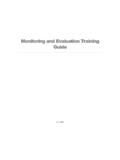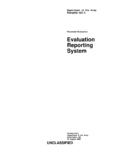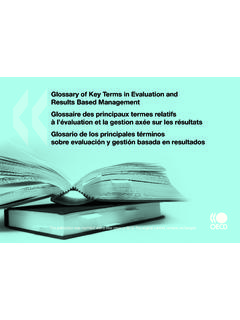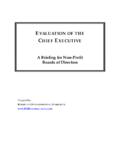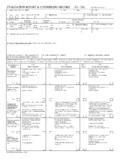Transcription of Monitoring and Evaluation Toolkit for Junior …
1 Monitoring and Evaluation Toolkit for Junior Farmer Field and Life Schools The designations employed and the presentation of material in this information product do not imply the expression of any opinion whatsoever on the part of the Food and Agriculture Organization of the United Nations concerning the legal or development status of any country, territory, city or area or of its authorities, or concerning the delimitation of its frontiers or boundaries. The mention of speci c companies or products of manufacturers, whether or not these have been patented, does not imply that these have been endorsed or recommended by the Food and Agriculture Organization of the United Nations in preference to others of a similar nature that are not mentioned.
2 ISBN 978-92-5-105724-7. All rights reserved. Reproduction and dissemination of material in this information product for educational or other non-commercial purposes are authorized without any prior written permission from the copyright holders provided the source is fullyacknowledged. Reproduction of material in this information product for resale or other commercial purposes is prohibited without written permission of the copyright holders. Applications for such permission should be addressed to: Chief Electronic Publishing Policy and Support Branch Communication Division FAO.
3 Viale delle Terme di Caracalla, 00153 Rome, Italy or by e-mail to: Photos: FAO/ , F. Dalla Valle, FAO Jerusalem Graphic design: Antonella Por do FAO 2010. Monitoring and Evaluation Toolkit Ms Terri Ballard, Ms Tanith , Ms Francesca Dalla Valle Monitoring and Evaluation Toolkit 5. ACKNOWLEDGMENTS. Under the supervision of Carol Djeddah (Gender, Equity and Rural Employment Division, ESW), this Module has been developed by Terri Ballard from FAO's Nutrition and Consumer Protection Division (AGNA), Tanith K. Bello from FAO Kenya and Francesca Dalla Valle from FAO's ESW.
4 Jaap Van de Pol provided the rst version of the tools. Comments, suggestions for improve- ment were provided by: Michele Tarsilla and Faria Zaman, Felicidade Panguene and Alves Nhaurire from FAO Mozambique, Winfred Nalyongo and Bernard Mwesigwa from FAO Uganda, Bonventure Achonga from the Ministry of Agriculture in Kenya, Karine Garnier from FAO Regional Emergency Of ce in Kenya and Daniel Baha from the Coast Development Authority (CDA) in Kenya. Appreciation is shown to Peter Wobst and Gabriel Rugalema from FAO's Gender, Equity and Rural Employment Division (ESW).
5 Special thanks are given to UNAIDS and the UN System-wide Work Programme on Scaling-up HIV services for Populations of Humanitarian for their key role in supporting the JFFLS and the de- velopment of the M&E manual. Monitoring and Evaluation Toolkit 7. Contents 1. INTRODUCTION 9. Workshop on JFFLS M&E 9. Development of a core JFFLS Monitoring and Evaluation Toolkit 10. 2. GETTING STARTED ON M&E KEY DEFINITIONS AND CONCEPTS 11. Monitoring 11. Evaluation 11. Monitoring and Evaluation plans 12. Logical framework 12. 3. Monitoring - PROCESS Evaluation 14.
6 Monitoring indicators 14. 4. Evaluation OF OUTCOMES AND IMPACT 15. What should JFFLS programmes be evaluating? 15. Who should carry out the Evaluation ? 15. Use of indicators to evaluate outcome and impact 16. Setting targets for results 18. Useful information for establishing targets 19. Attribution 19. Importance of the baseline 20. Quantitative outcome and impact Evaluation methods 21. Qualitative outcome and impact Evaluation methods 23. Proposing a mix of methods 25. 5. RECOMMENDED CORE M&E Toolkit FOR JFFLS 27. Core on-going Monitoring tools 30.
7 Core Evaluation tools 31. 6. DOCUMENTING AND REPORTING M&E RESULTS 34. 7. RESOURCES 35. Annex I - Monitoring TOOLS 37. Annex II - CORE YOUTH QUESTIONNAIRE 44. Annex III - EXAMPLE OF QUANTITATIVE INDICATOR CREATION 49. Annex IV - QUALITATIVE Evaluation TOOLS 53. Monitoring and Evaluation Toolkit 9. 1. INTRODUCTION. The JFFLS programme was piloted in Mozambique and Kenya in 2004 and JFFLS schools have been implemented since then in Burundi, Cameroon, DRC, Gaza & West Bank, Ghana, Malawi, Namibia, Nepal, Rwanda, Sudan, Swaziland, Tanzania, Uganda, Zambia and Zimbabwe.
8 Programme evaluations have been undertaken in ve countries up to now: Mozambique, Kenya, Uganda, Sudan and Gaza & West Bank. Monitoring and Evaluation (M&E) is an important aspect to undertake in a project or programme and supports the management work to ensure compliance of its strategies, objectives and approach. It is the mechanism for which the process aspects of a programme can be tracked and accounted for, as well as its impact assessed. M&E improves programme management and implementation and builds a case for advocacy. Workshop on JFFLS M&E.
9 FAO staff working in JFFLS programmes in ve countries (Kenya, Uganda, West Bank & Gaza Strip, Sudan and Mozambique) attended an M&E workshop on August 11-12, 2009 in Nairobi to reach consensus on core M&E tools, based on the piloting that was taken place in the ve countries, and to nalize the JFFLS M&E Toolkit . The speci c objectives of the workshop were to: 1 Understand experiences from the eld with M&E and use of existing JFFLS M . 2 De ne realistic expectations of the JFFLS (its desired impact and outcomes based on realistic appraisal of the project).
10 3 Identify a few simple core indicators of outcome and impact;. 4 Critically review all existing M&E tools for JFFLS and modify as indicated;. 5 Decide on (revised) tools to include in the nal JFFLS M&E Toolkit . Workshop participants acknowledged that programme managers as well as donors are aware of the dif culty in measuring the overall GOAL or desired IMPACT of JFFLS programmes. JFFLS are intended to improve livelihood possibilities for participants in the future in order to improve food security and (in certain areas) reduce the impact of HIV and AIDS on households.










